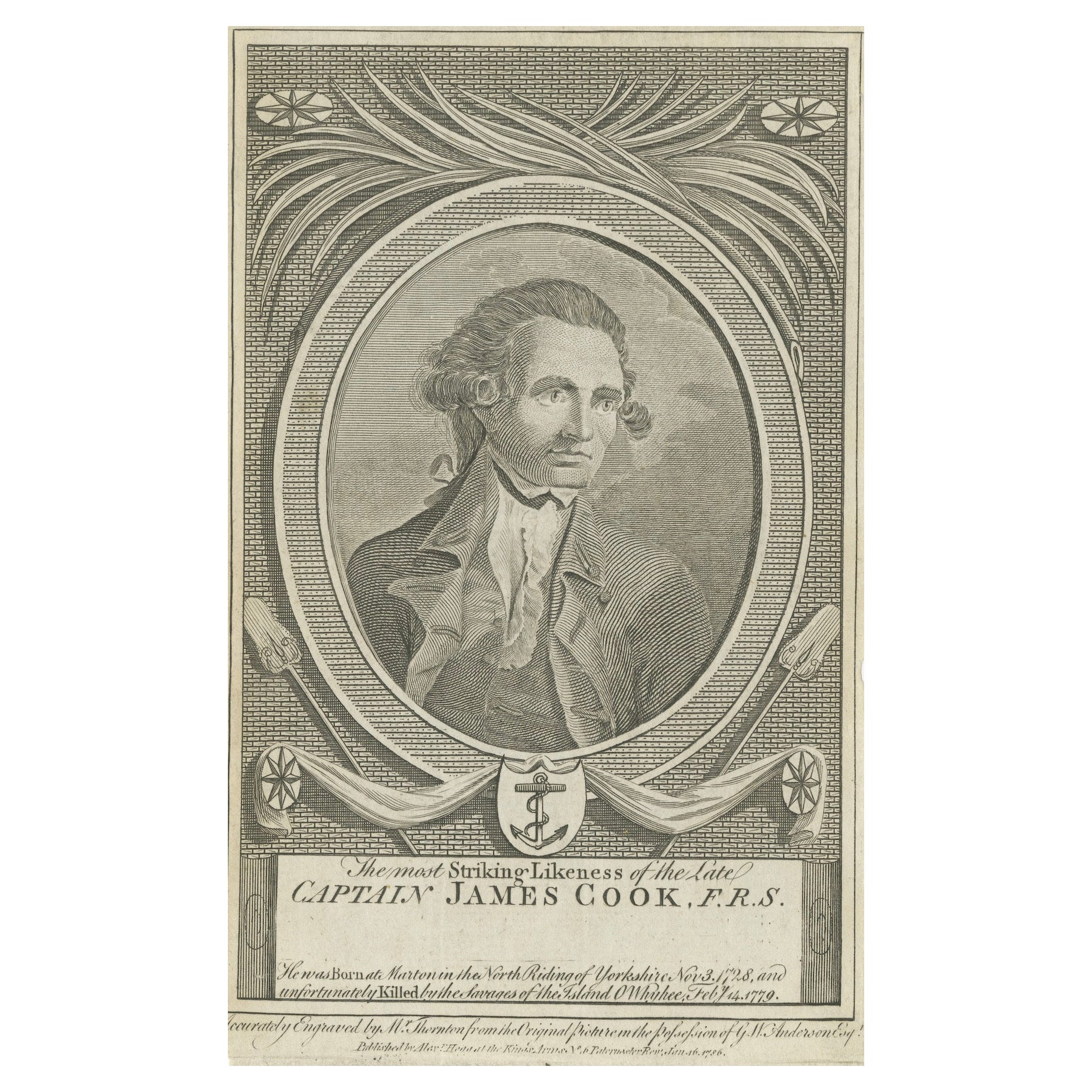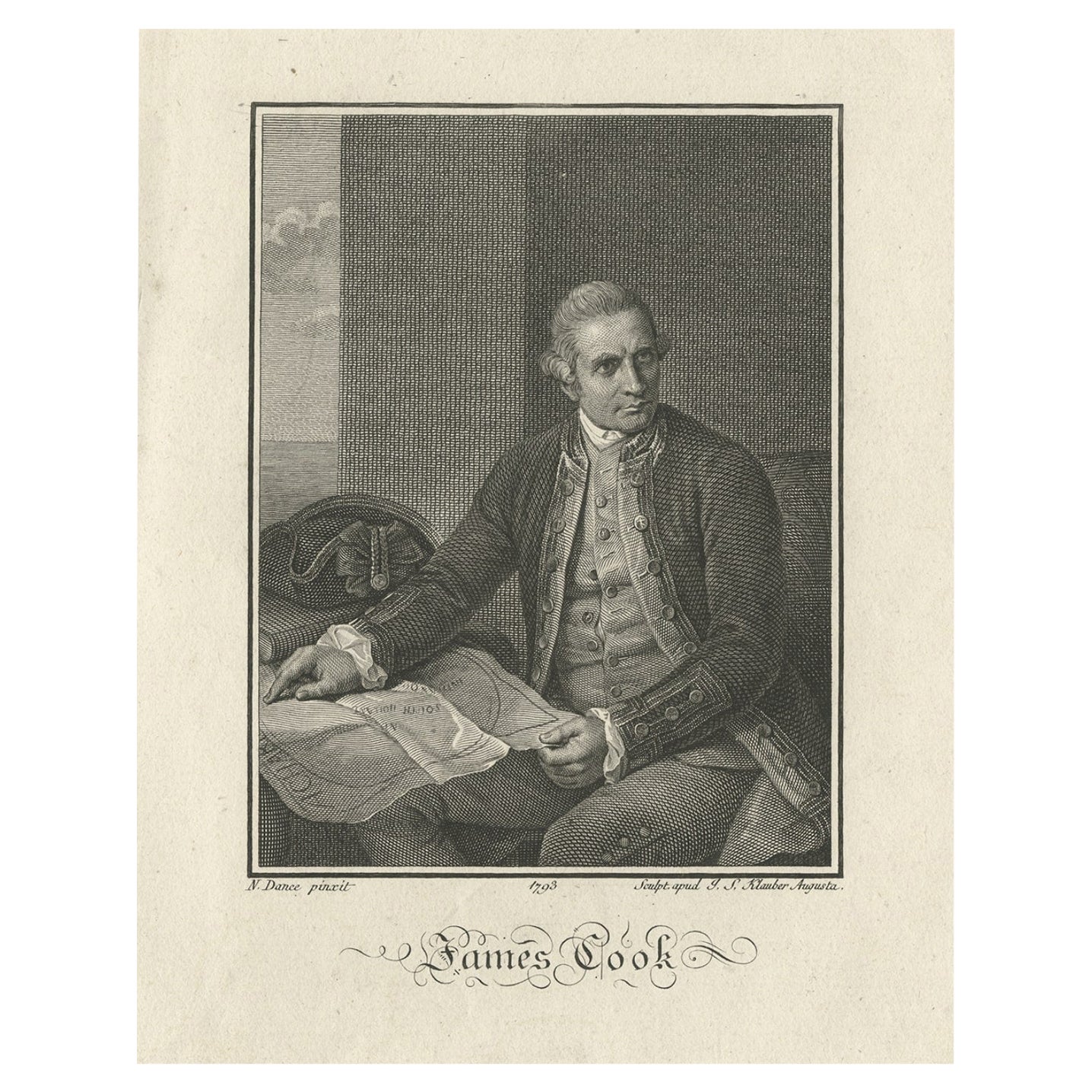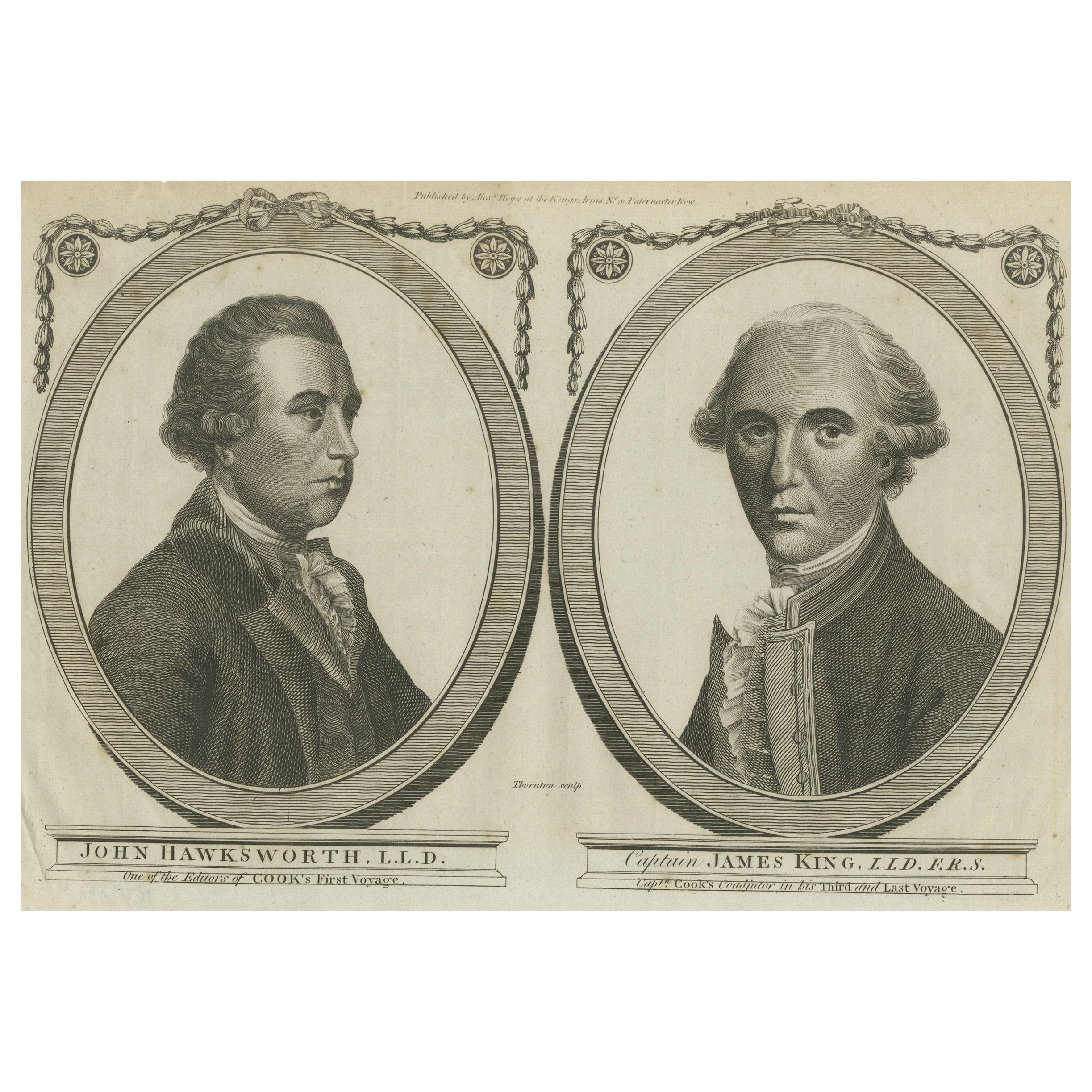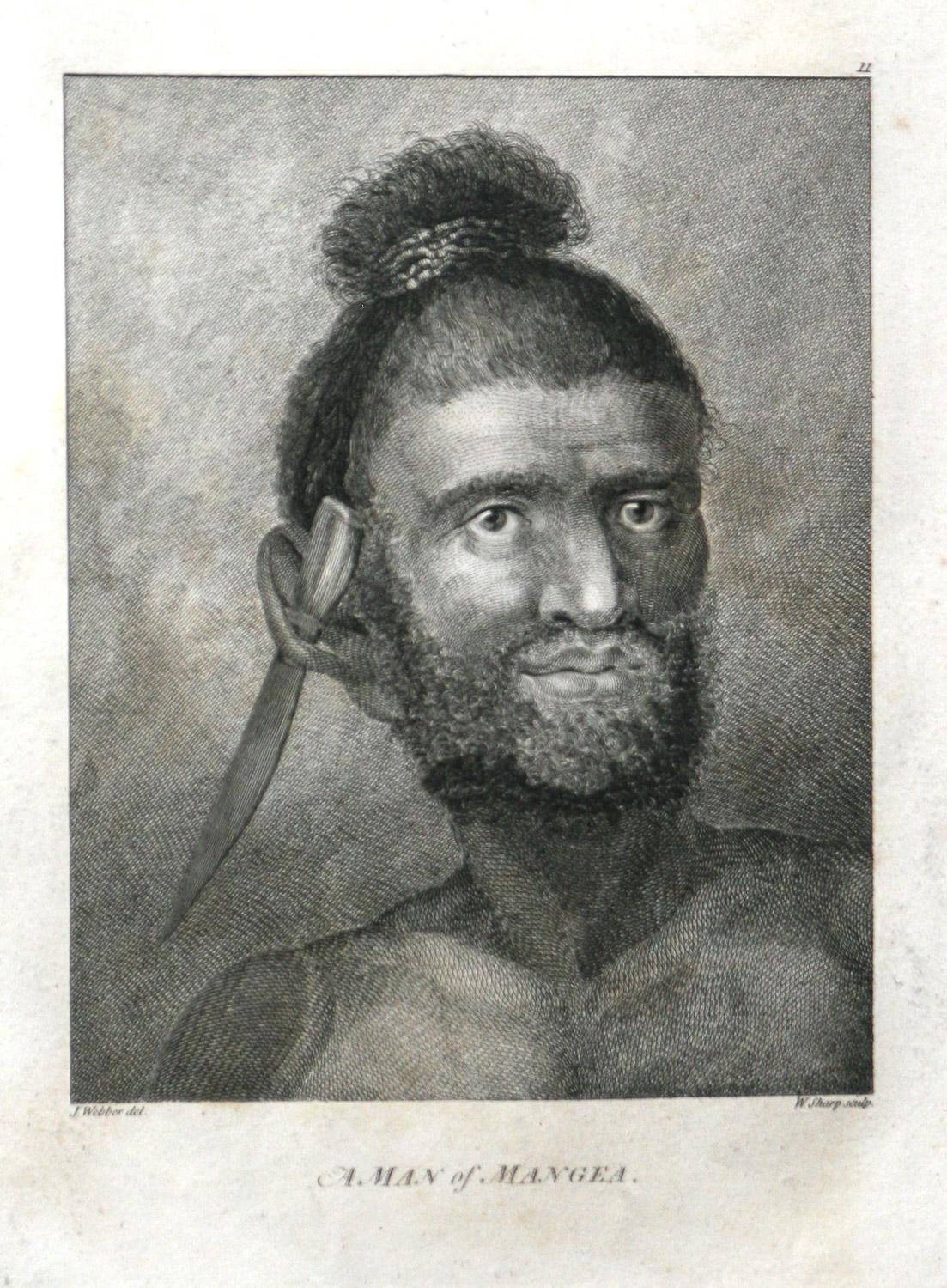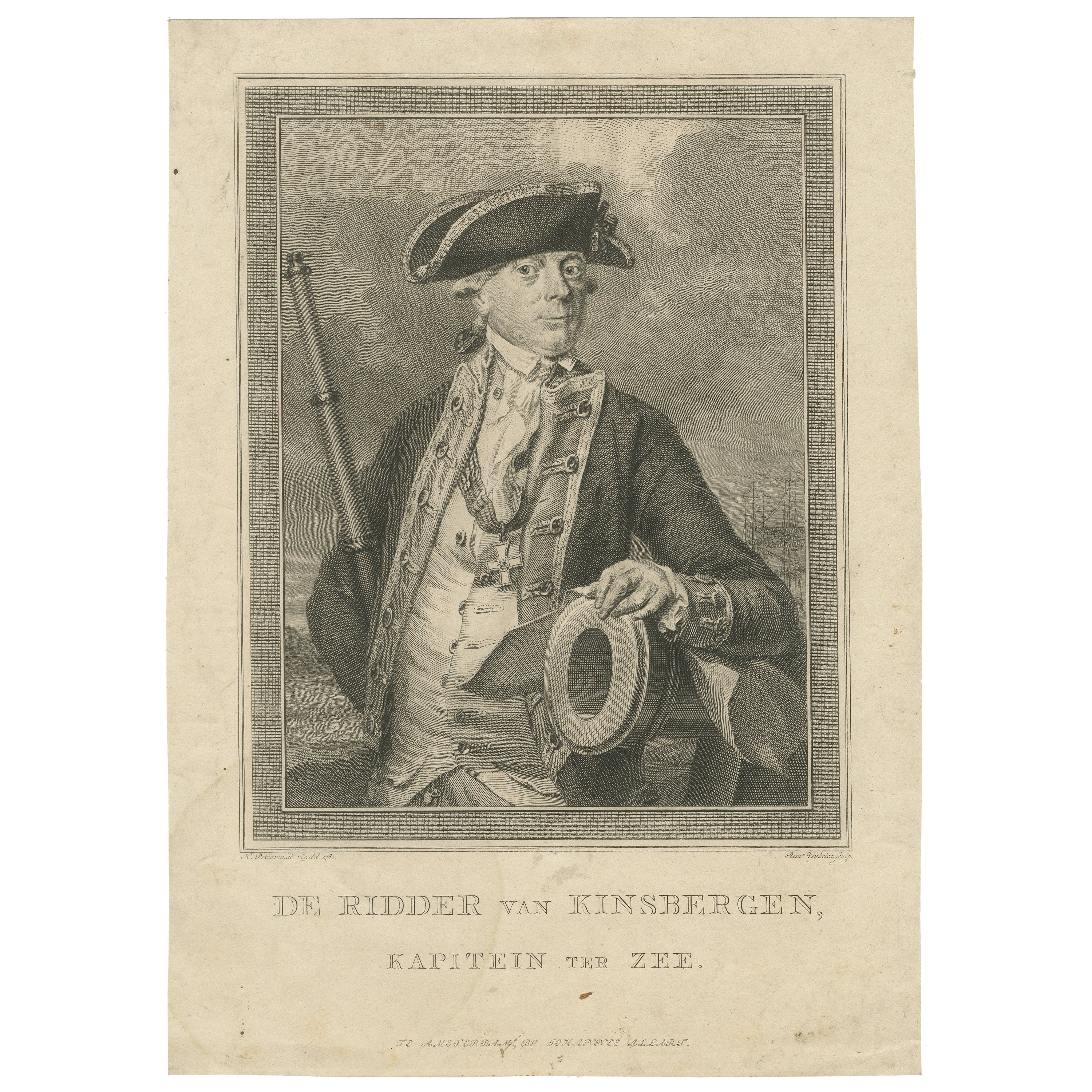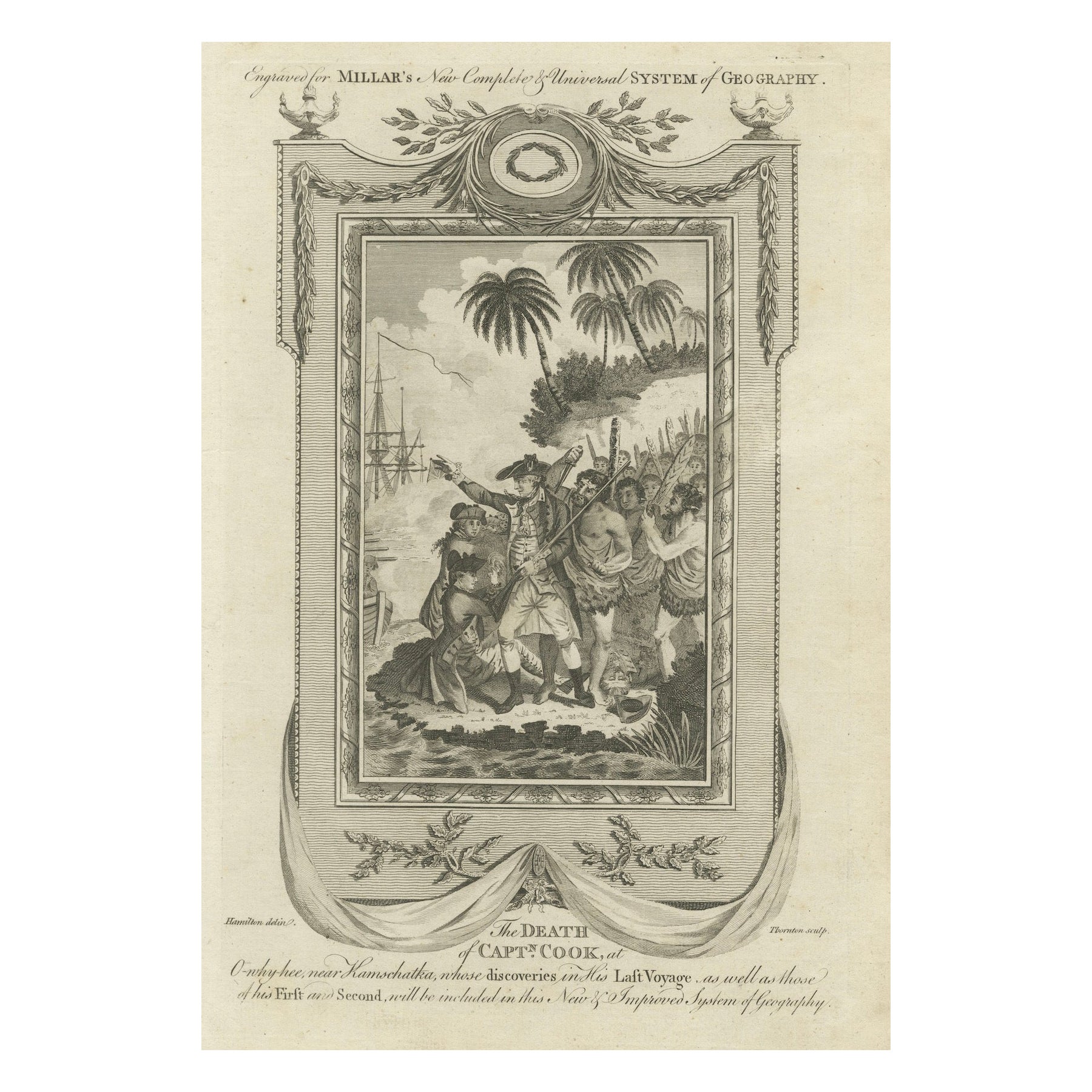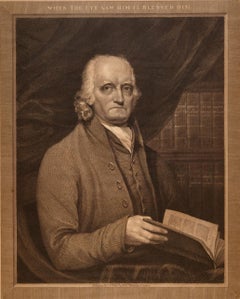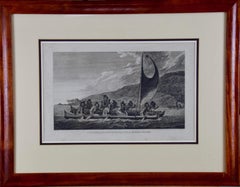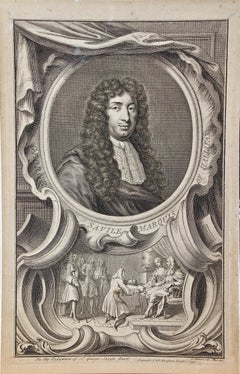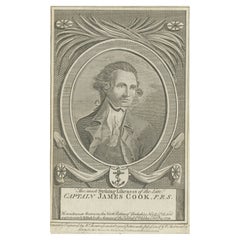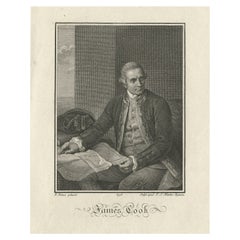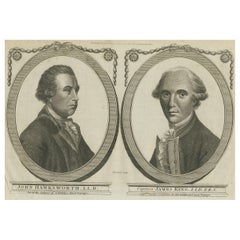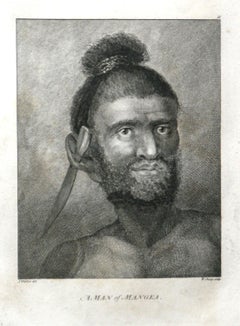Items Similar to Captain James Cook: 18th C. Portrait by William Hodges After Cook's 2nd Voyage
Want more images or videos?
Request additional images or videos from the seller
1 of 6
William HodgesCaptain James Cook: 18th C. Portrait by William Hodges After Cook's 2nd Voyage1777
1777
$1,100
$1,37520% Off
£847.31
£1,059.1420% Off
€967.53
€1,209.4120% Off
CA$1,569.17
CA$1,961.4720% Off
A$1,716.38
A$2,145.4820% Off
CHF 900.72
CHF 1,125.8920% Off
MX$20,526.99
MX$25,658.7420% Off
NOK 11,366.98
NOK 14,208.7320% Off
SEK 10,604.02
SEK 13,255.0320% Off
DKK 7,225.68
DKK 9,032.1020% Off
About the Item
This is an original 18th Century copper plate engraved portrait of Captain James Cook as a young man. It was engraved by J. Basire after a painting by William Hodges, published in London by W. Strahan and T. Cadell in the Strand in 1777 as the frontispiece to the official journal publication of Cook's 2nd voyage of discovery, "A voyage towards the South Pole, and round the World. Performed in His Majesty's ships the Resolution and Adventure, in the years 1772, 1773, 1774, and 1775". The journal was written by James Cook, Commander of the Resolution, which was the ship used for the voyage and William Hodges, who was the artist on board the ship. This famous image has been used in many articles and tributes to Captain Cook, including a Norfolk Island stamp celebrating his many accomplishments.
This engraved head-and-shoulders portrait of Captain Cook is enclosed in an oval with the appearance of a stone border. Captain Cook is dressed in his naval dress uniform, with a topcoat over a lace shirt. The engraving is printed on watermarked laid, chain-linked paper. The sheet measures 11.5" high x 9" wide. There is some spotting, most prominently in the margins. The print is otherwise in excellent condition.
Captain James Cook (1728-1779) was an English explorer, navigator, surveyor and cartographer, who dramatically changed what was known about the world through his three voyages of discovery in the 1770's. Cook's achievements are too numerous to include here, but for example, Cook charted much of the Pacific Ocean and discovered many island groups, including the Hawaiian islands, which he named the Sandwich Islands, in honor of the head of the British Admiralty and a patron of Cook's. Cook was the first European to explore the eastern coast of Australia, and he was the first to map the New Zealand coastline. He sailed farther south than any other explorer before him, disproving the belief that a huge land mass occupied the South Pole. He also explored the northwest coast of North America, including present day Alaska and adjacent portions of Russia. He proved that the Northwest Passage did not exist.
Cook was an exceptional seaman, navigator and leader of men, which contributed to the success of his explorations, but also saved his ship and crew on many occasions when faced with challenges, such as storms in previously unexplored waters, like occurred in the Great Barrier Reef off the eastern coast of Australia. He is also the first to require his crew to eat citrus fruit which markedly reduced the incidence of survey, which had led to large scale illness and death during earlier ocean voyages. As outstanding as Cook's skills were, they are even more impressive since they were self-taught. Having grown up the son of a farmhand in Northern England he had only four years of formal schooling. He taught himself astronomy, mathematics and other disciplines which were helpful when he continued his education, first in the merchant marine and then in the British Navy. Cook's adventurous career came to a sudden and unfortunate end in 1779, when he was killed in a confrontation with Hawaiian natives in Kealakekua Bay on the Kona coast of the big island of Hawaii.
- Creator:William Hodges (1744 - 1797)
- Creation Year:1777
- Dimensions:Height: 11.5 in (29.21 cm)Width: 9 in (22.86 cm)
- Medium:
- Period:1770-1779
- Framing:Framing Options Available
- Condition:
- Gallery Location:Alamo, CA
- Reference Number:Seller: # 5861stDibs: LU117328771742
About the Seller
5.0
Platinum Seller
Premium sellers with a 4.7+ rating and 24-hour response times
Established in 2011
1stDibs seller since 2019
298 sales on 1stDibs
Typical response time: 1 hour
- ShippingRetrieving quote...Shipping from: Alamo, CA
- Return Policy
More From This Seller
View AllRichard Reynolds, Society of Friends: 19th C. Engraved Portrait by Wm. Sharp
By William Sharp
Located in Alamo, CA
This is an early 19th century engraved portrait of the industrialist and philanthropist Richard Reynolds by William Sharp after William Hobday. It was published in London by Rudolph Ackerman in 1817. The print is entitled "Richard Reynolds of the Society of Friends, Late of Bristol". This three-quarter length portrait of Reynolds depicts him seated, directed to right, looking towards the viewer. He is holding an open book, wearing a plain suit. A curtain in the background is pulled to the left, revealing bookshelves. Some of the books are labelled 'Addison & Watts' 'Kempis & Fenelon' 'Milton & Cowley' etc. The inscription above the portrait reads: "When the eye saw him it blessed him". The lettering below the image reads: "Richard Reynolds of the Society of Friends, Late of Bristol; Whose Life and Fortune were devoted to the Glory of God by relieving the humble in Distress.', This plate is dedicated by Permission to his Royal Highness, the Prince Regent by his most devoted very humble servant William Hobday."
This engraving is printed on thick paper. The sheet measures 16" high and 12" wide. It is adhered to an archival backing in the upper left corner. There is mild discoloration and toning in the margins, but it does not involve the image.
Richard Reynolds (1735-1816) was a prominent member of the Society of Friends, also known as Quakers, in the 18th and 19th centuries. He was born into a wealthy family in Bristol, England, and inherited a successful copper smelting, iron manufacturing business from his father. Despite his privileged upbringing, Reynolds was known for his deep concern for the poor and his commitment to social justice. He used his wealth and influence to support a range of philanthropic causes, including the abolition of slavery, the improvement of working conditions for miners and factory workers, and the provision of education for the poor. Reynolds was also a prominent supporter of the Quaker...
Category
Early 19th Century Portrait Prints
Materials
Engraving
Reception for Captain Cook, Tonga: Original 18th C. Engraving, Cook's 3rd Voyage
By John Webber
Located in Alamo, CA
"The Reception of Capt. Cook in Hapaee" is an original 18th century engraving from a drawing by John Webber (1751-1793), who was the artist who accompanied Captain Cook on his third ...
Category
1780s Landscape Prints
Materials
Engraving
Sandwich Islands Canoe (Hawaii): Framed 18th C. Engraving Captain Cook's Journal
By John Webber
Located in Alamo, CA
"A Canoe of the Sandwich Islands, the Rowers Masked" is an engraving created by Charles Grignion, from a drawing by John Webber (1752-1793), who was the artist on Captain James Cook's 3rd and final voyage of discovery. It is Plate 65 in the atlas of "A Voyage to the Pacific Ocean Undertaken by the Command of His Majesty, for Making Discoveries in the Northern Hemisphere", the official British Admiralty sanctioned journal published upon completion of the voyage in London in 1784 by Strahan & Cadell.
This famous image of ten Hawaiian rowers transporting a priest who is carrying a feather-covered image of Kukailimoku, the Hawaiian god of war. The priests and paddlers are all wearing gourd masks in their double-hulled canoe with an upright lateen woven sail. Each hull was shaped from a single large Koa log harvested from island rainforests, where they were carved before being transported to the coast.
This engraving is presented in a Koa wood frame and a white mat. There are occasional faint spots, but the print is otherwise in very good condition. Koa is the same wood as was used to make the canoe. Koa wood is legendary in Hawaii. Not only is this amazing wood native to Hawaii, but it is known for the deep rich colors and varied grain pattern. Koa has an honored heritage in Hawaii and is highly revered and sacred. The word “koa” means “warrior” in Hawaiian. The warriors of King Kamehameha the Great, created canoes and weapons from a wood plentiful on the Big Island of Hawaii. This wood became synonymous with the warriors themselves, and it became known as koa. The frame measures 20.75" high, 26.75" wide and 0.88" deep.
There are three other engravings listed from the official journal of Captain Cook's 3rd voyage available that are presented in identical Koa wood frames and mat (LU117324682022, LU117324684052, LU117324684062). They would make a wonderful grouping for a display of 2, 3 or 4 prints. A discount is available for a grouping depending on the number of items included.
Hawaii was discovered by Captain Cook (1728-1779) during this voyage. Hawaii was originally called The Sandwich Islands in honor of The Earl of Sandwich...
Category
1780s Landscape Prints
Materials
Engraving
18th Century Engraved Portrait of George Savile, Marquis of Halifax by Houbraken
By Jacobus Houbraken 1
Located in Alamo, CA
A superb 18th century engraved portrait of George Savile, Marquis of Halifax, Plate 82 in "The Heads of Illustrious Persons of Great Britain", written by...
Category
Mid-18th Century Realist Portrait Prints
Materials
Laid Paper, Engraving
Four Koa Wood Framed 18th C. Engravings from Captain Cook's 3rd Voyage Journal
By John Webber
Located in Alamo, CA
A grouping of four framed engravings of Hawaii, Tahiti, Tonga and Vancouver Island from the atlas of the official British Admiralty sanctioned journal of Captain Cook's 3rd Voyage entitled "A Voyage to the Pacific Ocean Undertaken by the Command of His Majesty, for Making Discoveries in the Northern Hemisphere", published upon completion of the voyage in London in 1784 by Strahan & Cadell. These engravings were made from drawings by John Webber (1752-1793), who was the artist on Captain James Cook's 3rd and final voyage of discovery. The set of engravings includes: "A Canoe of the Sandwich Islands, the Rowers Masked", Plate 65 in the atlas; "A Dance in Otaheite" (Tahiti), Plate 28; "King of the Friendly Islands" (Tonga), plate 20; "Inside of a House in Nootka Sound" (Canada), plate 42.
These engravings are professionally framed in Koa wood, the same wood as was used to make the canoes of the ancient Hawaiians. Koa wood is legendary in Hawaii. Not only is this amazing wood native to Hawaii, but it is known for the deep rich colors and varied grain pattern. Koa has an honored heritage in Hawaii and is highly revered and sacred. The word “koa” means “warrior” in Hawaiian. The warriors of King Kamehameha the Great, created canoes and weapons from a wood plentiful on the Big Island of Hawaii. This wood became synonymous with the warriors themselves, and it became known as koa.
These four engravings would make a wonderful grouping for a display of 2, 3 or 4 prints. They may be purchased separately or in groups on 1stDibs. Their listing Reference #'s are: LU117324682432, LU117324682022, LU117324684052 and LU117324684062. A discount is available for a grouping depending on the number of items included.
Hawaii was discovered by Captain Cook (1728-1779) during this voyage. Hawaii was originally called The Sandwich Islands in honor of The Earl of Sandwich...
Category
1780s Other Art Style Landscape Prints
Materials
Engraving
$7,660 Sale Price
20% Off
Sir. John Powell, Knight: Early 18th C. Engraved Portrait After William Sherwin
Located in Alamo, CA
This is an early 18th century portrait of Sir John Powell entitled "The Honorable Sr. John Powell, Knight. one of the Justices of her Majesties' Court of Common Pleas. Ano. D 1711". It was engraved and published by John King in London in 1711, after an earlier work by William Sherwin. The engraving depicts a bust length portrait of Powell wearing an elaborate fir-trimmed robe and collar. The portrait is encompassed in an ornate oval frame, sitting on a pedestal with an impressive coat-of-arms below.
This engraved portrait is printed on laid, chain-linked watermarked cream-colored paper The sheet measures 15.25" high and 11.38" wide. It is adhered to an archival thick card at the upper corners, There is a 1/8" tear at the lower edge of the sheet, but the print is otherwise in very good condition. This engraving is held by museums and institutions, including the British Museum and the Harvard University Art Museum.
Sir John Powell (1632-1696) was an English lawyer and judge who served as a justice of the King's Bench from 1683 until his death. He was born in Glamorganshire, Wales, and studied at Jesus College, Oxford, before being called to the bar at the Middle Temple in 1656. Powell was known for his staunch support of the monarchy and the Church of England, and he played a prominent role in the trial of the Whig leader Lord William Russell in 1683, which resulted in Russell's execution for his alleged involvement in a plot to assassinate King Charles II. Powell was also involved in the trials of several other prominent Whig politicians, including Algernon Sidney and Titus Oates. In addition to his work as a judge, Powell was also a member of Parliament for various constituencies throughout his career, and he served as Solicitor General and Attorney General for Wales under King James II. However, he opposed James's efforts to promote Catholicism and supported the Glorious Revolution of 1688, which led to James's overthrow and the installation of William and Mary as joint monarchs.
Powell was known for his intellectual rigor and his legal expertise, and he authored several influential legal treatises during his lifetime. He was widely respected by his peers and by the legal community as a whole, and his legacy as a jurist and judge continues to be celebrated today.
William Sherwin (1645-1709) was an English engraver who worked during the late 17th and early 18th centuries. He was born in Chesterfield, Derbyshire, and is known for his high-quality engravings of various subjects, including portraits, landscapes, and architectural views. Sherwin was trained as an engraver and worked as an apprentice to the renowned engraver Robert White. After completing his training, he went on to establish his own studio in London, where he produced a significant body of work over the course of his career. One of Sherwin's most famous works is his engraving of the portrait of John Locke...
Category
Early 18th Century Old Masters Portrait Prints
Materials
Engraving
$620 Sale Price
20% Off
You May Also Like
1786 Engraved Portrait of Captain James Cook by M. Thornton
Located in Langweer, NL
Captain James Cook, depicted in a period-style coat with a cravat. His hair is styled in a manner typical of the late 18th century, combed back and ...
Category
Antique 1780s Prints
Materials
Paper
Antique Portrait of James Cook, 1803
Located in Langweer, NL
Antique portrait titled 'James Cook'.
Antique portrait of James Cook. Originates from 'Reizen Rondom de Waereld door James Cook (..)'.
Artists and E...
Category
Antique Early 1800s Prints
Materials
Paper
Engravings of Hawkesworth & Captain James King: Chroniclers of Capt. Cook, 1784
Located in Langweer, NL
Commemorative Portraits of John Hawkesworth and Captain James King by Thornton
This detailed engraving, crafted by the artist Thornton, presents a pair of oval portraits depicting t...
Category
Antique 1780s British Prints
Materials
Paper
A Man of Mangea 1784 final voyage of Captain Cook by John Webber
By John Webber
Located in Paonia, CO
A Man of Mangea is from the 1784 First Edition Atlas Accompanying Capt. James Cook and King; Third and Final Voyage of Captain James Cook. John Webber (1752-1793) was the official a...
Category
1780s Realist Portrait Prints
Materials
Engraving
Antique Naval Portrait – Jan Hendrik van Kinsbergen, Dutch Sea Captain, c.1785
Located in Langweer, NL
Antique Naval Portrait – Jan Hendrik van Kinsbergen, Dutch Sea Captain, c.1785
This finely detailed late 18th-century engraving depicts Jan Hendrik van Kinsbergen (1735–1819), one o...
Category
Antique Late 18th Century Dutch Prints
Materials
Paper
Engraving of The Tragic Demise of Captain James Cook in 1779 in the South Seas
Located in Langweer, NL
The engraving titled "The Death of Captn. Cook" depicts the dramatic and tragic event of Captain James Cook's death. This artwork is intricately framed with ornate borders and decora...
Category
Antique 1780s Prints
Materials
Paper
$416 Sale Price
20% Off
More Ways To Browse
Antique Cook
18th Century Copper
Captain Cook
Hawaiian Antique
Antique Portrait Plates
Antique Surveyor
Northwest Coast
Antique Navigator
Cook Islands
New Zealand Map
Sandwich Islands
Antique Maps New Zealand
Dali Desert
Erte Poster
Female Art Deco Nude Corne Akkers
George Burns
Goodall Frederick
Grant Wood Paintings
